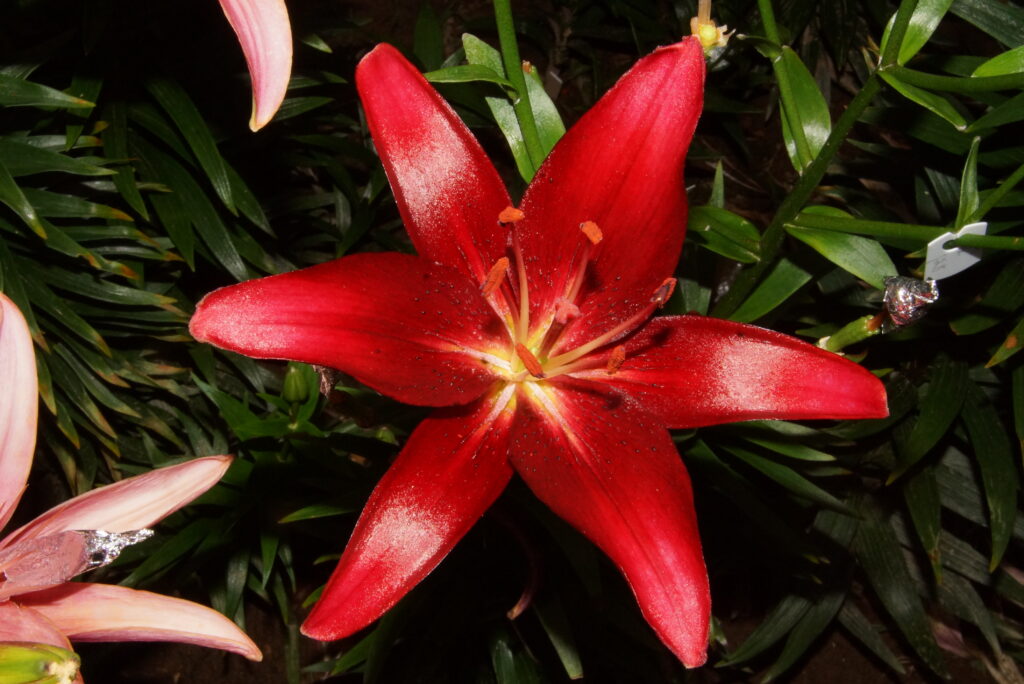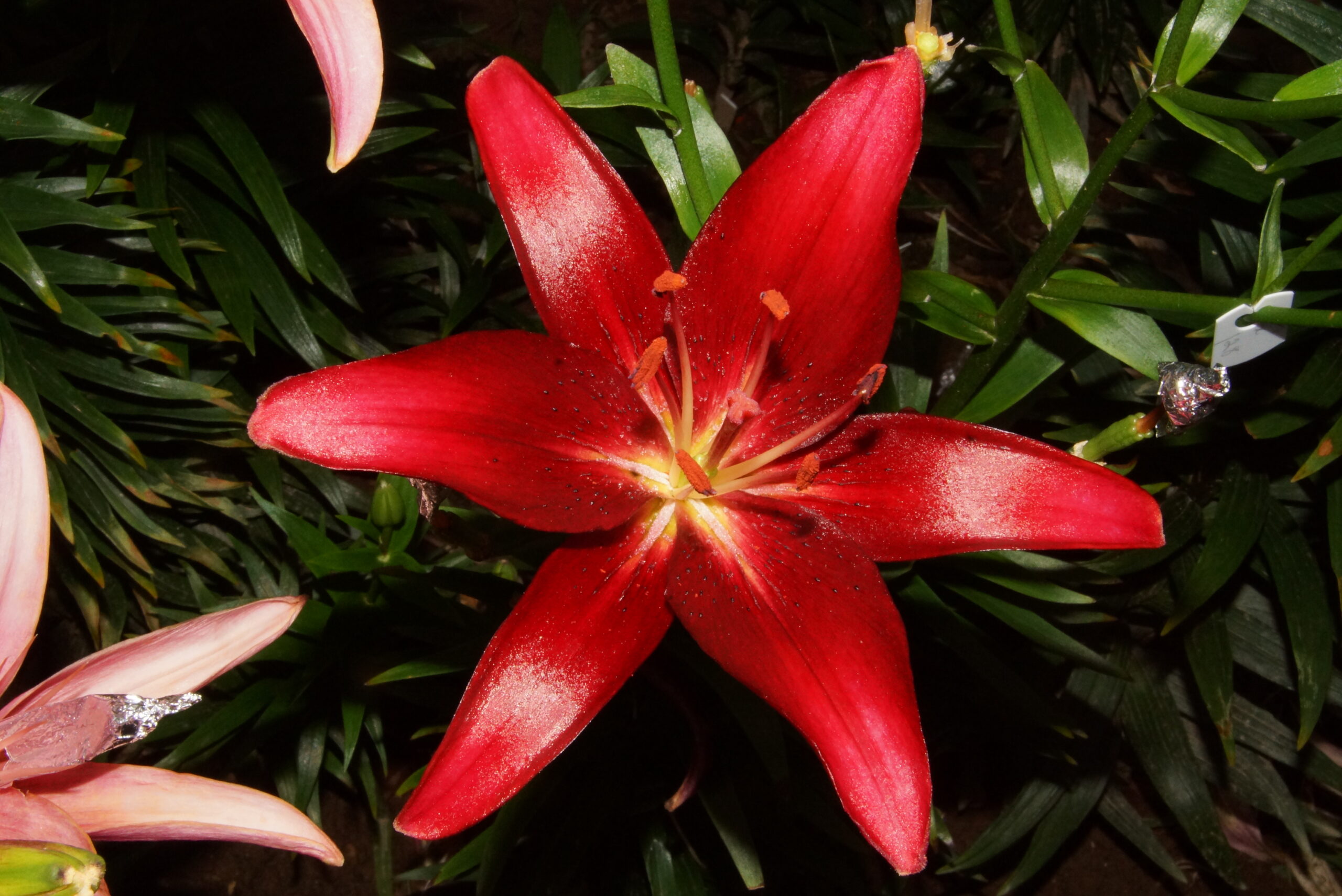by Arthur Evans, Gravette, Arkansas

My wife, Crow, is very good about sharing the kitchen with my non-cooking projects. You know, ordinary things like brewing beer, sterilizing soil in the oven, making nutrient medium for the embryo cultures, nuking critter-infested bulbs in the microwave, and storing an unreasonable number of lily bulbs in the refrigerator. She does raise an eyebrow, however, when I start playing with poisonous chemicals in the food prep area.. That’s one reason I decided to switch from colchicine to oryzalin for my conversion attempts as per Dr. Jaap van Tuyl’s article in the NALS Yearbook. Oryzalin is alleged to be much less toxic to people than colchicine. By the same token it is supposedly more effective in interrupting normal mitosis in rapidly dividing lily cells, which can result in producing a tetraploid bulblet from a diploid lily scale. It works; I’ve done it. Here’s how.
Oryzalin is sold by Dow-Elanco as a pre-emergence herbicide under the name Surflan AS. It comes in one gallon jugs of 40% active ingredient, at a cost of about $100 per gallon. I got mine from Hummert Co., Inc., the well known horticultural supply company. Since Dr. van Tuyl advises the .005% strength treatment solution, I calculate that one gallon of Surflan AS would make a fair sized swimming pool of solution, more than enough, even for an obsessive-compulsive gardener like me. Oh well, maybe I’ll use the rest for the intended purpose on the label. Seriously though, if my math is correct, .5 ml of 40% oryzalin dissolved in 4 liters of water makes an approximately .005% oryzalin treatment solution. That sounds weak, but don’t be tempted to make it stronger.
Oryzalin is hard to dissolve in water. Wearing latex exam gloves and a moisture-resistant surgery mask from my Dental office, I pre-dissolved .5 ml (easy to measure with an allergy injection syringe from the drug store) in .5 cup of warm isopropyl alcohol (or vodka), then added it in increments to warm water in a clean milk jug with violent agitation and incantations. The incantations are optional, but the looks on the faces of the grandchildren are priceless. I presume this solution is fairly stable, but I make up a new batch after treating two batches of scales.
Use fresh scales right off the bulb, but none that show any rotten spots. Outer scales make more bulblets than the little thin ones near the core. Don’t wait until callus and tiny bulblets are forming on the broken edge of the scale bases. The more tissue the drug has to penetrate in order to reach the actively dividing meristematic cells, the less likely you will be to get a completely converted tetra bulblet. If a bulblet arises from a mixture of converted and non-converted cells, we call it a mixoploid. Many of these plants eventually revert to diploid status, some say because diploid cells grow and divide faster than tetra cells and tend to take over completely in time. An exception seems to be when a plant has sex cells that are tetra but all other cells are diploid, as in the stable chimera cultivar, ‘Capri’. I used its pollen with tetras to good effect, though it has not been on the market for some time.
Now, for the actual treatment bear in mind that the drug only works on cells that are actively dividing, so it makes sense that you want to use a temperature appropriate for rapid cell division and a treatment time long enough to intercept lots of cell divisions. I don’t know what the optimum temperature or treatment time is for most lilies. It may vary with the genetic background of the cultivar you are working with. What I have done is soak scales in covered quart jars in the hot water heater closet at about 75 degrees F. for 6 hours. I make sure all jars, scales, and solution are close to the chosen treatment temperature before I start. After treatment, I rinse the scales lightly with clean water and drain well.
Oryzalin is toxic, so handle treated scales only with gloved hands. Be a fanatic about cleaning all equipment and food preparation surfaces as soon as you have placed the scales in labeled plastic bags of very slightly moist sphagnum or vermiculite. I use a Sharpie pen to label the bag with cultivar name, date of treatment, and any variation from standard treatment. Previously, I used Zip Lock Vegetable bags with the ventilation holes. Then all bags go into a larger plastic bag with loosely closed top to keep the smaller bags from drying out. The big bag then gets incubated at about 75 degrees F. from October or November until bulblets are well formed, usually about the end of February or March. Check scales weekly for rot or shriveling. Water slightly if shriveled; replace wet medium with dry if you find rot. In early March the bulblets are vernalized , simulating winter chill, in the refrigerator at 35 degrees F. for 3 months. Then they should be ready to grow leaves.
After vernalization, I inspect the bulblets individually, looking for physical characteristics which may indicate conversions. Most bulblets will look quite ordinary because they are still unconverted. If you said the aforementioned incantation properly, however, you may find a few (5%-10% at best) bulblets which have obviously shorter, thicker scales which stand apart from each other at the base at about 90 degrees or more. I plant these bulblets in large pots and protect them from all harm. A high percentage of these odd-looking bulblets will soon show the large stomates (.005+ inches long) on the underside of the leaf which indicate conversion to tetraploid status. Congratulations! Ordinary looking bulblets are planted in rows in the garden . Their stomates are checked when they leaf out to see if I missed any tetras. I don’t have much space, so I don’t grow out the diploids.
When large enough to bloom, test the converted tetras both ways in crosses with fertile seed grown tetras. There will be variations in fertility between different conversions from the same batch of the same cultivar. Due to the low number of successful conversions in each batch, I would certainly advise you to start with at least 100 clean, healthy scales of each cultivar. If you start with large bulbs you can usually harvest 10-20 usable scales from each one. Scaled cores can be treated with fungicide and replanted in the garden to grow again.
In dozens of attempts I was only able to convert one cultivar, the old Ib pink ‘Gypsy’, with colchicine. In the Fall of 1993 I attempted to convert 8 cultivars with oryzalin, and I succeeded in converting 4 of them. They were ‘Yellow Star’, ‘Connecticut Star’, ‘Shirley’, and ‘Nutmegger’. These were used in crosses with modern tetra cut-flower types with some success before they were lost to rodents and the inherent lack of vigor found in most converted tetras.
I believe there will always be a place for excellent diploid lilies. Indeed, many of the best garden genotypes are still in the diploid gene pool. Getting these superior genes into the polyploid gene pool is a worthwhile goal for amateur and professional breeders alike. Some of these diploids can be used with tetras to produce new tetras in (tetra X diploid) crosses if the diploid produces significant amounts of unreduced (tetra-like) pollen. ‘Connecticut King’ does that. Other diploids may produce a few triploid embryos when pollinated by tetras, though most of the triploid embryos are not wrapped in normal endosperm, so they need embryo rescue. Many diploids, however, refuse to participate in such liberal nonsense as crossing with polyploids. In such a predicament the only solution is to convert the diploid to tetraploid status. There is much to do, and though it is time consuming, it is not too difficult for kitchen technology. Hopefully, your spouse will be as understanding as mine has been.
